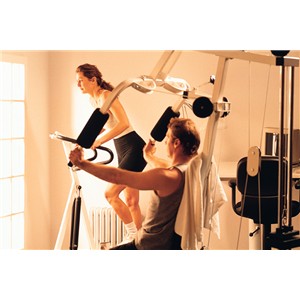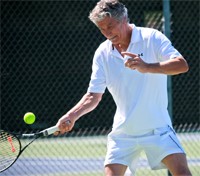|
|
Circuit Training
Author:
Stan Reents, PharmD
Original Posting:
05/06/2007 06:21 AM
Last Revision: 12/10/2018 05:36 AM
 What is circuit training? What is circuit training?
Circuit training is an exercise program that develops overall fitness. Performed regularly, circuit training will simultaneously improve muscular strength, endurance, cardiovascular fitness, and flexibility.
During a typical weight-training session, there is generally a substantial amount of rest between sets. In contrast, during circuit training, the rest intervals are very short. In order to accommodate shorter periods of rest, circuit training utilizes a higher number of repetitions with a lower resistance (compared to a typical weight-training program).
The weight-lifting portion of a circuit training workout involves exercising many major muscle groups. This is often combined with several different aerobic exercises. This combination of weight-lifting (resistance training) with aerobic exercise forces your heart to work harder. Circuit training leads to improvements in both muscular endurance and cardiovascular fitness.
Circuit training as a concept is not new. In fact, it has been around since 1981 (Gettman LR, et al. 1981).
"FITT": FREQUENCY, INTENSITY, TIME, TYPE
In general, exercise programs are described in terms of FITT:
- frequency: number of times per week
- intensity: how hard you exercise
- time: duration of each exercise session
- type: the type of exercise being performed
Using the FITT model, here are some general guidelines for designing a circuit training program:
- Frequency: 2-3 times/week.
- Intensity: Set the resistance on each machine to 40-70% of your maximal effort and perform 12-15 reps, depending on your current level of strength and endurance. Try to complete your reps within 20-30 seconds, but don't sacrifice proper form in doing so. If you are completely fatigued during one exercise after 15 reps, then reduce the amount of weight for that exercise. If, on the other hand, 15-20 reps do not seem very challenging, then increase the weight. Try to limit your rest between each machine to 15-30 seconds.
- Time: Try a program that requires about 30 minutes to complete when you first start. Then, build up to 45-60 minutes.
- Type: Circuit training works best on weight-machines. Free weights can be used, but, generally it is not wise to perform certain free weight exercises without a spotter. Your goal should be to utilize 6-10 stations in the beginning, and work up to 12-15 stations as you get fitter and stronger.
EXAMPLE OF A CIRCUIT PROGRAM
One concept to keep in mind when doing a total body weight-training workout is to work the larger muscles first and the smaller muscles last. The reason for this is that generally you can lift more weight with your larger muscle groups. You don't want your smaller muscle groups (which are used to help maintain proper form and control) to be fatigued. Admittedly, this concept may be more relevant when free weights are used, however it is still a logical concept for working out on weight machines.
The following routine is just one example, but carefully note that a given muscle group is never exercised twice in a row. Goal: 12-15 reps at each station with 15-30-second rest intervals:
| MUSCLE GROUP |
EXERCISE |
| Chest |
bench press |
| Legs: quads |
squats or leg press |
| Back |
back extension (machine or stability ball) |
| Abs |
crunches (machine, stability ball, or on the floor) |
| Shoulders |
overhead press, military press |
| Legs: hamstrings |
leg curl |
| Lats |
lat pull-down |
| Arms: triceps |
triceps extension |
| Legs: calves |
toe-raises (machine or free weights) |
| Arms: biceps |
curls (machine or free weights) |
The above routine incorporates 10 major exercises. As you progress, you can add more. If you want more of a cardiovascular element in the circuit, use shorter rest intervals or include some dynamic activity during the rest interval (eg., jumping rope or bench stepping).
RECOMMENDATIONS
Circuits are a great way to obtain total body training, burn calories and improve aerobic performance. But, prior to arriving at the gym, you should consider the following:
• What is your goal? Are you interested in a total body workout or do you just want to concentrate on specific muscle groups? Circuit training involves all major muscle groups since, in order to minimize the amount of rest between exercises, one muscle group is rested while you work on another area.
• Does your facility offer the variety of machines necessary for exercising all major muscle groups? Are they readily accessible so that you can keep your rest periods as short as possible? Rest periods should be brief. So, use weight machines where you can select your weight quickly and easily and use machines that are in close proximity to each other.
• You may want to pick a time of day when your facility is not crowded so that, again, you can complete your program uninterrupted.
• Remember to drink plenty of water after each workout. Also, within 30 minutes after your session, consider taking in both carbs and a little protein to give your muscles the substrates they need for repair and growth.
• Finally, and most importantly, don't push yourself beyond your capacity. And, certainly, stop exercising immediately if you feel faint, develop chest pain or shortness of breath, or develop a headache. Don't be afraid to modify that day's exercise plan based on how you are feeling.
FOR MORE INFORMATION
Readers may also be interested in these reviews:
EXPERT HEALTH and FITNESS COACHING
Stan Reents, PharmD, is available to speak on this, and many other exercise-related topics. He also provides a one-on-one Health Coaching Service. Contact him through the Contact Us page.
REFERENCES
Gettman LR, Pollack ML. Circuit weight training: a critical review of its physiological benefits. Phys Sports Med 1981;9:44-60. (no abstract)
ABOUT THE AUTHOR

Stan Reents, PharmD, is a former healthcare professional. He is a member of the American College of Lifestyle Medicine (ACLM) and a member of the American College of Sports Medicine (ACSM). In the past, he has been certified as a Health Fitness Specialist by ACSM, as a Certified Health Coach by ACE, as a Personal Trainer by ACE, and as a tennis coach by USTA. He is the author of Sport and Exercise Pharmacology (published by Human Kinetics) and has written for Runner's World magazine, Senior Softball USA, Training and Conditioning and other fitness publications.
Browse By Topic:
aerobic exercise, resistance training, strength exercise
Copyright ©2025 AthleteInMe,
LLC. All rights reserved.
|
|